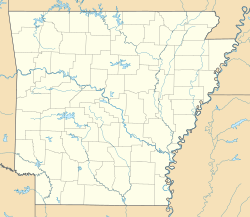Marche, Arkansas facts for kids
Quick facts for kids
Marche, Arkansas
|
|
|---|---|
| Country | United States |
| State | Arkansas |
| County | Pulaski |
| Elevation | 269 ft (82 m) |
| Time zone | UTC-6 (Central (CST)) |
| • Summer (DST) | UTC-5 (CDT) |
| ZIP code |
72113, 72118
|
| GNIS feature ID | 77596 |
Marche (sometimes called Warren) is a small place in Pulaski County, Arkansas, United States. It's an unincorporated community. This means it's not an official city or town with its own local government. Instead, it's part of the larger county. Marche is about 12 miles (19 km) north of Little Rock.
Contents
History of Marche
Early Attempts to Settle
Marche's story began in 1872. A judge named Liberty Bartlett tried to start a settlement there. He wanted to call it Bartlett Springs. However, his plan didn't work out.
Later, a railroad company bought the land. They named the spot Warren Station. There was also a plan to turn the area into a fun resort. This resort would have been for people from Little Rock. But this idea also failed by 1877.
Polish Settlement
In March 1877, a special person bought the land. He was Count Timothy von Choinski, a Polish nobleman. A nobleman is a person from a high social class. He bought a very large piece of land, about 22,000 acres (89 square kilometers).
Count Choinski had a big dream. He wanted to help Polish immigrants who were living in difficult conditions. Many Poles lived in crowded areas of big cities. These cities included New York and Chicago. He wanted to give them a better life. He hoped they could live on farms, like many Poles did before coming to America.
He named the new settlement Marche. This word is French for "marketplace."
Building a Community
In May 1877, 22 immigrants visited the land with Count Choinski. They liked what they saw and agreed to settle there. Different groups of Polish people started moving to the land that summer.
Some people went back home when they saw the land wasn't cleared yet. But 85 people stayed. They became the first group of settlers for the new community.
By the fall of 1878, a group of Catholic priests and brothers heard about Marche. They were called the Holy Ghost Fathers. Father Anthony Jaworski built a small chapel for the community. It was named for the Immaculate Heart of Mary. The chapel was built on a hill. The immigrants called this hill Jasna Góra. This name came from an important pilgrimage site in Częstochowa, Poland. A pilgrimage site is a holy place people travel to for religious reasons.
A bigger church building was built in 1896. Sadly, it was destroyed by fire in 1932. A new church was finished and dedicated in May 1933.
Marche Today
Marche continued to grow over the years. In 1941, the population was 72 people. During World War II, a federal camp expanded nearby. This meant 40 families had to move from their homes.
Today, the Immaculate Heart of Mary Church is still important to the community. In 1999, they finished building a parish center. A parish center is a building used for church activities and community events. The church still celebrates Karnawał. This is a special celebration of the community's Polish heritage.


